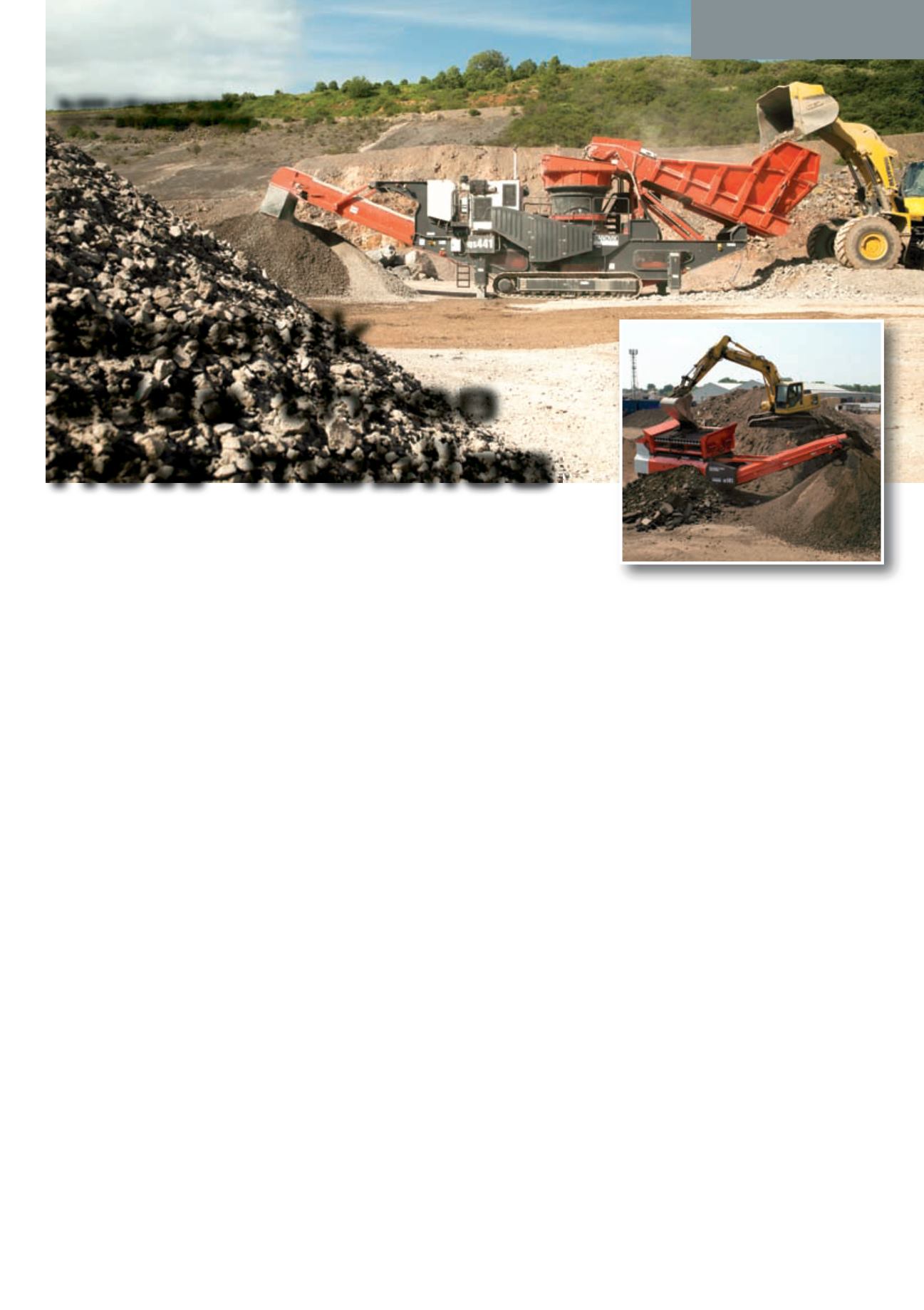
35
d
&
ri
NOVEMBER-DECEMBER 2013
The larger QS441 56 tonne class unit
features the CS440 cone while the smaller,
more compact 36 tonne class QS331 uses the
CS430 cone crusher. There is a choice of three
concaves and four bush settings to control the
closed side settings and material gradation.
The new crushers are capable of producing
large reduction ratios with minimal fines.
Michael commented that because it had
a long steep cone, there was no need for a
large eccentric. He said that an increase in the
movement of parts led to more friction and
therefore more sand.
MAXIMISING PRODUCTION
Key features include an automatic level sensor
above the crushing chamber to control the
feed rate and minimise operator intervention
for maximum production and reduction,
and a metal detector is fitted as standard to
provide stability and protection from tramp
material. There is a remote camera to view
the crushing chamber from ground level and
a hydroset CSS regulation system to optimise
production and keep track of liner wear.
Four hydraulic jacking legs provide
stability and a level operating platform,
while the heavy duty I-beam chassis is said
to ensure maximum durability. A Cat C13
diesel engine with direct drive is designed to
provide maximum power delivery and fuel
efficiency, and a hydraulically-driven cooling
fan with auto-reverse function can back flush
dust from the radiator. The QI341 impact
crusher uses the Prisec technology introduced
by Sandvik some years ago.
Michael said, “It is now a crusher and
screener in one. The big thing about this
unit is the screen box. A lot of these are a
compromise as they can never be as good as a
big stationary unit, because a stationary unit
is a much more expensive and much larger."
“What we are trying to do is to get a big
stationary unit into a small block that we can
transport around the world. The bottleneck in
units is usually the screens, and this unit has
a 1.5 x 4.2 m (5 x 13.8 ft) screen – that’s huge
for this size of unit.”
The QI341 is now available with an
optional hanging screen system to allow
customers an even greater return on
investment by being able to produce
accurately sized products for immediate use.
The QI341 uses Sandvik impactor
technology in a fully mobile, compact impact
crusher designed to work either in a primary
or secondary capacity, independently or
in conjunction with other members of the
Sandvik product line.
The QE141 mobile scalper is the latest
Robotrac track-mounted screener. Michael
said: “The Robotrac came out in 1995 and
this unit changed the world market for mobile
crushers because before that it was a wheeled
market with very little on tracks.”
The QE141 can create a windrow or radial
stockpile, or simply a 300 tonne conical
stockpile, load a truck, a screen or a pug mill
with its heavy duty double-deck vibrating
grid, which is tipped by remote control.
Alternatively, the QE341 can be fitted with
fine grade meshes for precision screening and
sizing applications.
The QE141 features, as standard, a Cat
engine and serviceability has been improved.
Michael said: “Make the unit easily accessible
for service then the guy will service it. If it is
not easy to get in to service it, he won’t.”
■
Sandvik has added two new mobile cones and an impactor is
now available with optional hanging screen system, plus the
latest incarnation of Robotrac
S
andvik Construction has expanded
its mobile crusher portfolio with the
introduction of the new QS441 and
QS331 track-mounted cone crushers.
Its QI341 impact crusher is now available
with an optional hanging screen and Sandvik
has unveiled the QE141, the latest version of
what it claims was the first mass-produced
track-mounted screen, the Robotrac.
Michael Brookshaw, Sandvik distributor
manager EMEA for mobile crushers and
screens, said, “For Sandvik mobiles globally,
we had a very good start to the year. We
were definitely on budget, but we have seen
a slowdown in the third quarter – but this is
across the board on the world markets.”
Sandvik said the S type gyratory cone
crusher has proved itself in stationary
applications for over 30 years. It has now been
incorporated into a self-contained, diesel
driven track-mounted plant.
Michael said, “The big thing is that we’re
using standard technology that we’ve been
applied for many years, but what we’ve done
is put two parts of the technology together.”
Sandvik is using the standard frame from
existing units and the S cone gyratory cone
that it has been selling “for decades”.
“Everybody said ‘We need that cone on
that frame’, and that is basically what we’ve
done,” he continued. “We’ve made changes to
the frame – not major changes – and we’ve
managed to put this very tall cone on it.”
He said the S type gyratory cone was able
to accept a feed size up to 90% larger than
current standard cones to allow maximum
productivity from the primary crusher or
even enable the S cone to be operated as a
primary crusher in gravel applications.
EQUIPMENT
The QS441 at 56 tonnes is the larger
of two new cone crushers from Sandvik
The QE141 mobile scalper is the latest version of the
Robotrac track-mounted screen
Sandvik
adds three
new mobiles


